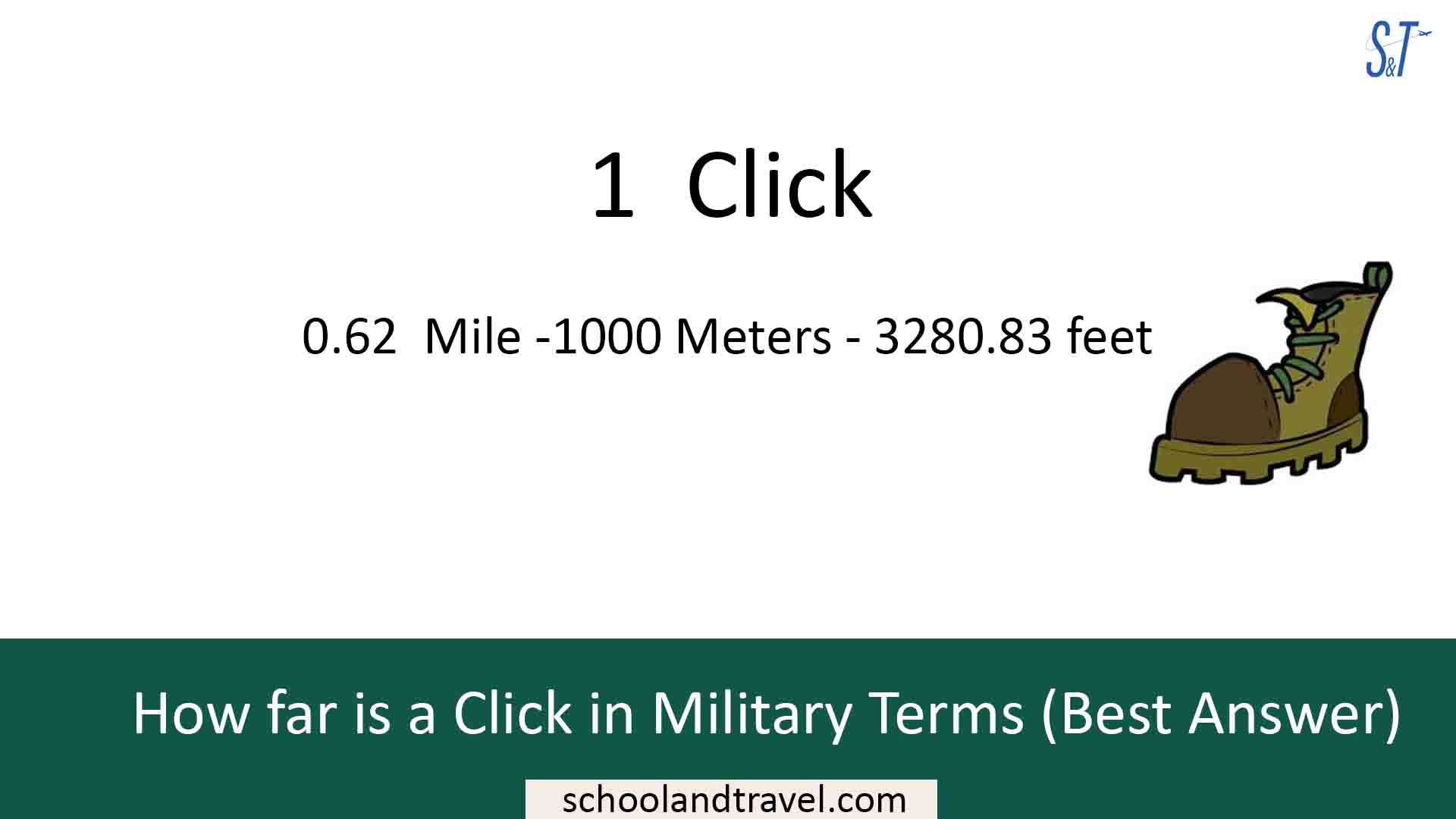Sometimes will be wondering and asking yourself, “What is a Click” and “How far is a Click/Klick in Military Terms?”. These questions might seem jargon but have deep meanings in Military terms.
In a situation in which you want to go into the military after College, you should get little knowledge of some of these terms so that you are not blank when some asks, “How far is a Click/Klick in Military Terms”.
A click, also called a “click,” is the same as a distance of 1 kilometer or 0.62 miles in the US & UK military. The use of the word, “Klick” came into existence during the Vietnam war.
According to LBC, Ex-military Steve says that if given a grid reference by a colleague, he would take a Click as 1km to find the location of his colleague from the map.
This article will help you understand the following: How far is a click in feet, How far is a click in miles, What is a Click in the army, How far is a klick in miles, How far is a kilometer, How far is a klick/Click.
History of the Word “Klick” or “Click”
Military historians say the name originated with the Australian Infantry in Vietnam. Infantrymen navigated by bearing and measured distance by pacing (this was, of course, before GPS devices).
One or two soldiers would count their paces to measure distance. 100 meters equals 110 level steps, 100 downhill steps, or 120 uphill steps. The soldier marked each 100-meter “lot” by manipulating the L1A1’s gas regulator.
After 1000 meters, the soldier would signal the section commander using hand gestures, lift the weapon and rewind the gas regulator with a thumb movement, resulting in an audible “click.”
Table describing the Value of “How far is a Click/Klick“:
| 1 Click | 0.62 Mile | 1000 Meters | 3280.83 feet |
| 2 Click | 1.24 miles | 2000 Meters | 6561.68 feet |
| 3 Click | 1.86 miles | 3000 Meters | 9842.52 feet |
| 4 Click | 2.49 miles | 4000 Meters | 13123.36 feet |
| 5 Click | 3.11 miles | 5000 Meters | 16404.20 feet |
| 6 Click | 3.73 miles | 6000 Meters | 19685.04 feet |
| 7 Click | 4.35 miles | 7000 Meters | 22965.88 Feet |
| 8 Click | 4.97 miles | 8000 Meters | 26246.72 Feet |
| 9 Click | 5.59 miles | 9000 Meters | 29527.56 Feet |
| 10 Clicks | 6.21 miles | 10000 Meters | 32808.39 Feet |
| 11 Clicks | 6.82 miles | 11000 Meters | 36089.24 Feet |
| 12 Clicks | 7.44 miles | 12000 Meters | 39370.0 Feet |
| 15 clicks | 9.30 miles | 15000 Meters | 49212.59 Feet |
| 20 clicks | 12.43 miles | 20000 Meters | 65616.79 Feet |
| 25 clicks | 15.53 miles | 25000 Meters | 82020.99 Feet |
| 30 clicks | 18.64 miles | 30000 Meters | 98425.19 Feet |
| 50 clicks | 31.07 miles | 50000 Meters | 164041.99 Feet |
| 100 clicks | 62.14 miles | 100000 Meters | 328083.99 Feet |
| 500 clicks | 310.69 miles | 500000 Meters | 1640419.95 Feet |
| 1000 clicks | 621.37 miles | 1000000 Meters | 3280839.89 Feet |
| 5000 clicks | 3106.86 miles | 5000000 Meters | 16404199.47 Feet |
| 10000 clicks | 6213.71 miles | 10000000 Meters | 32808398.95 Feet |
Read this: Capstone Project (Everything you need to know)
Other Military Distance Measurements
1. Latitude
It takes around 69 miles, or 364,000 feet, to cover one degree of latitude (111 kilometers). It is also possible to divide a degree of latitude into minutes of latitude, each of which is 6,068 feet (1.15 kilometers) in length (1.85 km).
A nautical mile is equivalent to one minute of latitude. Horizontal lines that are perpendicular to the Equator are known as latitudes. Each degree of latitude equals roughly 69 miles.
2. Knots
The knots on the medal might also be called “hitches” or “loops” due to their military origins. These rectangular clasps can have one to five knots, depending on the material.
For aviation and naval warfare purposes, one nautical mile per hour (or 1.852 kilometers per hour) is defined as one knot.
3. Longitude
The term “longitude” refers to the direction in which a position is located relative to the prime meridian. Meridians, or lines of longitude, are fictitious boundaries that cut the planet in half.
They extend due north from pole to pole yet use east-west measurements. Declination, arcminutes, and arcseconds are the standard units of longitude measurement.
In geography, longitude refers to the lines that run vertically from pole to pole. The longitude of a place is the angle made between the Prime Meridian and a vertical line from north to south.
4. Nautical miles
The term “nautical mile” refers to a unit of measurement used in air, sea, and space navigation and delineating maritime boundaries.
On the surface of the Earth, one nautical mile is equivalent to 1.852 kilometers or 1,852 meters. That’s the same as one minute of latitude.
The term “nautical mile” refers to a unit of measurement used in air, sea, and space travel to delineate national boundaries.
For those keeping score at home, one nautical mile is equivalent to 1,852 meters or 1.852 kilometers around the globe. Furthermore, it coincides with one minute of latitude.
Frequently Asked Questions (FAQs) on Klick in Military Terms
0.62 Mile
Nautical miles (and their related speed unit, knots) are used primarily to facilitate faster chart reading. Latitude and longitude are used on maps since that’s how you locate things. This is why they have a grid of latitude and longitude coordinates.
MGRS coordinates
Latitude describes how far north or south of the equator a location is. Parallels of latitude are the ring patterns around the Earth that run perpendicular to the equator. Distances are measured in a north-south direction, even though lines of latitude go east to west.
Final tips:
On the other hand, a Klick, in Military terms, is used to shift a rifle’s direction to the target’s distance. It can mean One Minute of Arc or one inch distance at one hundred yards.
I hope this article will help you understand the following:
- How far is a click in feet
- How far is a click in miles
- What is a Click in the army
- How far is a klick in miles
- How far is a kilometer
- How far is a klick/Click
I hope you learned something new today. Thanks for reading this article.
Read more:
- 10 Schools to Study in the United States Without IELTS
- Is Chemistry Harder to Study than Physics? (FAQs)
- Is Business Administration a Hard Course to Study? (FAQs)
- 11+ Best Study Tools For Medical Students (FAQs)
- Is College free in Canada? (Why Study, FAQs)
- 10 Cheapest Universities in Bangladesh (Reasons, Study, FAQs)
Sharing is Caring.





